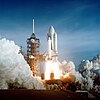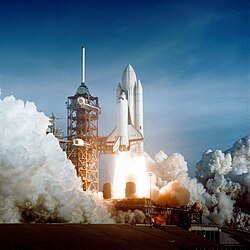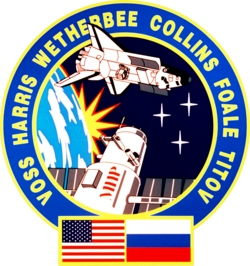STS-63
| Missionsemblem | |||
|---|---|---|---|
 | |||
| Missionsdaten | |||
| Mission | STS-63 | ||
| NSSDCA ID | 1995-004A | ||
| Besatzung | 6 | ||
| Start | 3. Februar 1995, 05:22:04 UTC | ||
| Startplatz | Kennedy Space Center, LC-39B | ||
| Raumstation | Mir | ||
| Anzahl EVA | 1 | ||
| Landung | 11. Februar 1995, 11:50:19 UTC | ||
| Landeplatz | Kennedy Space Center, Bahn 15 | ||
| Flugdauer | 8d 6h 28min 15s | ||
| Erdumkreisungen | 129 | ||
| Umlaufzeit | 91,0 min | ||
| Apogäum | 342 km | ||
| Perigäum | 310 km | ||
| Zurückgelegte Strecke | 4,8 Mio. km | ||
| Mannschaftsfoto | |||
 v. l. n. r. Vorne: Janice Voss, Eileen Collins, James Wetherbee, Wladimir Titow; Hinten: Bernard Harris, Michael Foale | |||
| ◄ Vorher / nachher ► | |||
| |||
STS-63 (englisch Space Transportation System) ist eine Missionsbezeichnung für das US-amerikanische Space Shuttle Discovery (OV-103) der NASA. Der Start erfolgte am 3. Februar 1995. Es war die 67. Space-Shuttle-Mission und der 20. Flug der Raumfähre Discovery.
Mannschaft
Hauptmannschaft
- James Wetherbee (3. Raumflug), Kommandant

- Eileen Collins (1. Raumflug), Pilotin

- Michael Foale (3. Raumflug), Missionsspezialist

- Janice Voss (2. Raumflug), Missionsspezialistin

- Bernard Harris, (2. Raumflug), Missionsspezialist

- Wladimir Titow (3. Raumflug), Missionsspezialist
 Russland
Russland
Ersatz
- Sergei Krikaljow
 für Titow
für Titow
Missionsüberblick

STS-63 führte das erste Rendezvous einer US-Raumfähre (mit Pilotin Collins erstmals von einer Frau gesteuert) mit der russischen Station Mir durch, die zu dieser Zeit mit Alexander Wiktorenko, Waleri Wladimirowitsch Poljakow und Jelena Kondakowa besetzt war. Die Discovery näherte sich Mir bis auf elf Meter, hielt diese Position eine viertel Stunde und zog sich dann auf eine Distanz von 122 Metern zurück. Im weiteren Verlauf der Mission setzte Kosmonaut Titow die Plattform SPARTAN 204 aus (MET 04/06:50) und fing sie wieder ein (MET 06/06:11). Außerdem verließen die beiden Missionsspezialisten Bernard Harris und Mike Foale die Raumfähre für einen viereinhalbstündigen Außenbordeinsatz zur Erprobung des neu konzipierten Raumanzuges (im Hinblick auf Wärmedämmung). Außerdem sammelten sie Erfahrung im Handhaben von schweren Massen im All (SPARTAN-Satellit).
Siehe auch
Weblinks
- NASA-Missionsüberblick (englisch)
- Videozusammenfassung mit Kommentaren der Besatzung (englisch)
Auf dieser Seite verwendete Medien
The April 12 launch at Pad 39A of STS-1, just seconds past 7 a.m., carries astronauts John Young and Robert Crippen into an Earth orbital mission scheduled to last for 54 hours, ending with unpowered landing at Edwards Air Force Base in California.
STS-63 Mission Insignia
Autor/Urheber: unknown, Lizenz:
STS-63 Crew
- Crew members assigned to the STS-63 mission included (front left to right) Janice E. Voss, mission specialist; Eileen M. Collins, pilot; (the first woman to pilot a Space Shuttle), James D. Wetherbee, commander; and Vladmir G. Titov (Cosmonaut). Standing in the rear are mission specialists Bernard A. Harris (the first Afro-American to walk in space), and C. Michael Foale. Launched aboard the Space Shuttle Discovery on February 3, 1995 at 12:22:04 am (EST), the primary payload for the mission was the SPACEHAB-3. STS-63 marked the first approach and fly around by the Shuttle with the Russian space station Mir.






